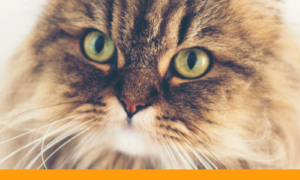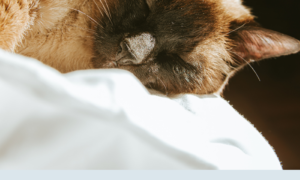By June Jackson for The Daily Cat

Every cat owner recognizes the warning signs of an upset feline stomach: the mournful meow, gagging and heaving retch. But in a flash, the cat seems to snap back to good health while you’re left scrubbing the carpet.
The scenario is a familiar one for many cat owners. This may happen every couple of months or so, but otherwise, cats are perfectly healthy.
Although it’s not a pleasant subject, vomiting is something cats seem to do almost on cue. Many cat owners accept this as a natural part of owning a pet, but it doesn’t have to be that way. Knowing what triggers an upset stomach and knowing how to treat feline stomach troubles will make for a much better relationship with your cat.
When to Worry
Repeated vomiting should never be ignored because it can lead to dehydration. But, since vomiting is common in cats, how do you know what’s normal? “A general guideline is that if the cat is vomiting one to three times a month, we consider this ‘normal,'” says Daniel Carey, DVM, Port Charlotte, Florida.
He considers it serious if the vomiting occurs twice daily for two or three days. If your cat stops eating, seems to have stomach pain, retches continuously or if there’s blood in the vomit, take it to a veterinarian. And, as always, if you’re suspicious that a lingering problem could be harmful to your pet, call your veterinarian. A visit to the office can help relieve your cat’s discomfort and your worries.
Why Cats Vomit
Many owners attribute their cat’s vomiting to hairballs, but that’s not the only culprit. “It’s careless to assume that most cases of vomiting in cats are due to hairballs,” says Dr. Carey. Other frequent causes of an upset stomach include:
- Eating too fast Cats sometimes eat too much, too fast. When the stomach wall expands too quickly, a signal is sent to the brain to cause regurgitation. In these cases, the mess on your floor is from regurgitation, not actual vomiting. When a cat regurgitates, he brings up fluid and food from the esophagus by opening its mouth — unlike vomiting, where there’s gagging and retching. Regurgitated food is still formed, and may smell fermented. “Cats that eat too quickly because they are gluttonous or stressed by food bowl competition can regurgitate right after eating,” says Dr. Carey. But don’t assume regurgitation is always a case of eating too fast. It could also be caused by esophageal problems, obstruction of the digestive tract, hairballs or dehydration. If you’ve forced your cat to eat slowly and it still has problems, contact a veterinarian.
- Curiosity Grass, carpet and toilet paper are just a few things cats may digest and later vomit. The vomiting is a protective mechanism — nature’s way of cleansing the system. Sometimes, though, curiosity can lead to more serious problems. String, toy parts and feathers are favorites of playful felines and can lodge in the stomach or intestine, causing repeated vomiting and severe distress. If your cat exhibits these symptoms, take it to a veterinarian immediately; surgery is often necessary to remove the object.
Preventive Measures
Often, owners accept their pet’s vomiting as a natural part of their behavior, but just because cats seem to have more than their fair share of tummy troubles doesn’t mean you have to sit idly by.
One simple preventive measure is to get your fast-eating cat to slow down or to simply eat less. Try these strategies: smaller portions, elevating your cat’s food dish slightly, or putting an object — such as a ball — into the dish. The cat will be forced to eat around the ball, and thus slow down its intake. If you do this, make sure the ball is clean and not so small that it could be swallowed. And you may need to feed cats in a multiple-cat household at different times and places to reduce competitive eating.
If simple solutions don’t work, watch your cat’s eating behavior and reactions. Some cat owners try changing their cat’s diets. If you think your cat has allergies, see your veterinarian, who can suggest the right formula for your cat.
Diet Matters
If you are changing your cat’s diet, try these strategies to make sure this change is as successful and comfortable as possible:
- Go slowly Make the transition gradually to allow your cat time to adjust. Make sure the cat eats something every day. “A cat that quits eating suddenly can develop liver problems.”
- Add appeal Switching from canned to dry or vice versa should also be done gradually. Many cats find canned food more palatable. If you switch to dry, add water and warm it slightly for more appeal. Discard uneaten food after 20 minutes to prevent spoilage.
- Measure up How much should you feed? Your cat’s age, gender, breed, activity level and overall health need to be taken into consideration. Talk with your veterinarian, then read the manufacturer’s recommendations.
- Pay attention Beyond careful measuring, also regularly weigh your cat and adjust the feeding amount accordingly after switching to a different food. Your cat may appear happy if you overfeed him. But over time, it may become overweight.
With a little effort on your part, your beloved cat’s tummy troubles can be a thing of the past.
June Jackson is a freelance writer and writes often about pets. Her work can be seen in magazines and newspapers nationwide.





